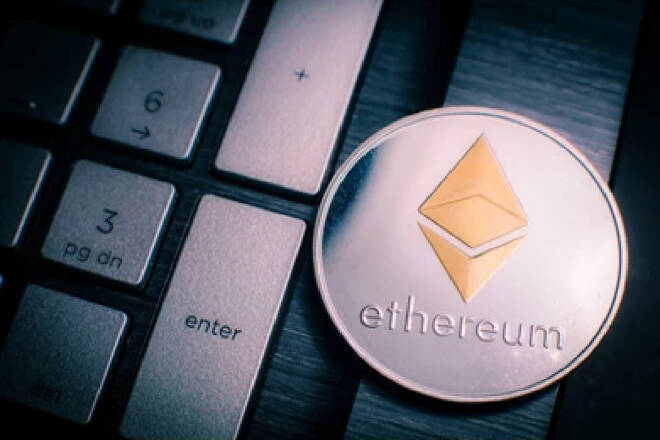Advertisement
Advertisement
ETH and Sub-$1,800 Hinged on US PPI Numbers and the SEC
By:
It was a bearish start to the Friday session, with ETH struggling after the latest US CPI Report and SEC Court filings to contest the Judge Torres ruling.
Key Insights:
- ETH saw red for the second consecutive session on Thursday, falling 0.16% to end the day at $1,852.
- Sticky US core inflation dragged ETH and the broader market into the red.
- The shorter-term technical indicators turned bearish, signaling a return to sub-$1,800.
Ethereum (ETH) fell by 0.16% on Thursday. Following a 0.05% loss on Wednesday, ETH ended the day at $1,852. Significantly, ETH held onto the $1,850 handle for the third consecutive session.
Ethereum Price Action
This morning, ETH was down 0.44% to $1,843. A mixed start to the day saw ETH rise to an early high of $1,854 before falling to a low of $1,844.
Daily Chart
The Daily Chart showed ETH hovering below the $1,865 – $1,895 resistance band. ETH sat below the 50-day EMA ($1,861) while holding above the 200-day ($1,789), sending bearish near-term but bullish longer-term price signals. Notably, the 50-day EMA narrowed to the 200-day EMA, a bearish price signal.
Looking at the 14-Daily RSI, the 45.79 reading reflects bearish sentiment, supporting a fall through the $1,815 – $1,795 support band to target the 200-day EMA ($1,789). However, an ETH move through the 50-day EMA ($1,861) would support a breakout from the $1,865 – $1,895 resistance band to target $1,950.
4-Hourly Chart
Looking at the 4-Hourly Chart, the ETH/USD faces strong resistance at $1,850. ETH sits below the $1,865 – $1,895 resistance band and the 200-day ($1,861) and 50-day ($1,846) EMAs, sending bearish near and longer-term price signals.
This morning the 50-day EMA eased back from the 200-day EMA, a bearish price signal.
An ETH move through the EMAs would support a breakout from the $1,865 – $1,895 resistance band to target $1,950. However, failure to move through the 50-day EMA would leave the $1,815 – $1,795 support band into play.
The 14-4H RSI reading of 48.11 sends bearish price signals, with selling pressure outweighing buying pressure. Significantly, the RSI leaves the $1,815 – $1,795 support band in play.
The SEC and the US CPI Report Leave ETH on the Defensive
On Thursday, the US CPI Report led to an afternoon pullback, with sticky core inflation dragging riskier assets into the red.
The US annual inflation rate accelerated from 3.0% to 3.2%, while the core inflation rate softened from 4.8% to 4.7%. Significantly, the numbers were softer than expected. Economists forecast an annual and a core inflation rate of 3.3% and 4.7%, respectively.
Investors initially responded positively to the headline inflation number that fell short of forecasts. However, elevated core inflation numbers ultimately weighed on the appetite for riskier assets, dragging ETH and the broader market into the red.
ETH remained sensitive to SEC-related news after SEC Chair Gary Gensler threw ETH into the ‘Crypto Securities Basket’ earlier this year.
SEC v Ripple case-related news added to the bearish sentiment as investors responded further to the latest SEC Court filing.
Staking Statistics Turned Bullish
According to CryptoQuant, staking inflows increased from 52,800 ETH on Wednesday to 66,400 on Thursday. Staking inflows turned more bullish after an extended period of below-trend inflows.
The overnight withdrawal profile was bearish, with principal withdrawals at above-normal levels. However, withdrawal projections for the morning session turned bullish. Projections show withdrawals will stay at normal withdrawal levels.
On Wednesday, the net staking balance stood at a 40,170 ETH surplus ($74.59 million), down 6% over 24 hours. Deposits totaled 54,270 versus withdrawals of 14,110 ETH.
According to TokenUnlocks, total pending withdrawals stood at 37,780 ETH, equivalent to approximately $69.81 million. Notably, the staking APR stood at 5.71%, down 0.17% over 24 hours. While the downward trend in staking APR remains bearish, the fall in total pending withdrawals and the increase in staking inflows are bullish price signals.
About the Author
Bob Masonauthor
With over 28 years of experience in the financial industry, Bob has worked with various global rating agencies and multinational banks. Currently he is covering currencies, commodities, alternative asset classes and global equities, focusing mostly on European and Asian markets.
Did you find this article useful?
Latest news and analysis
Advertisement
